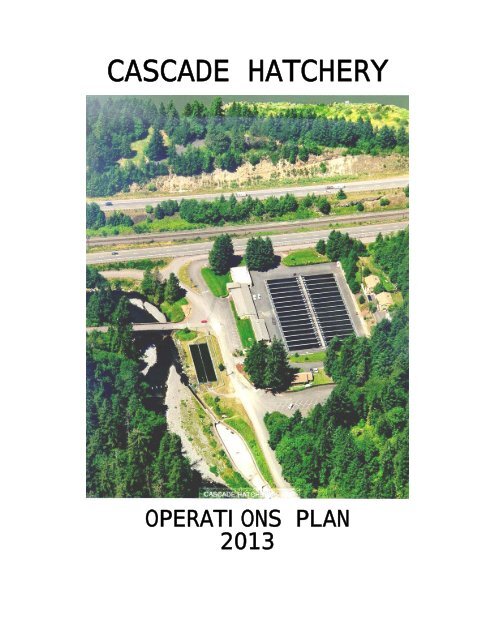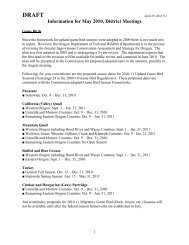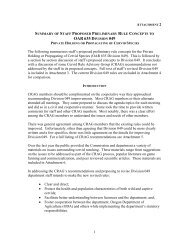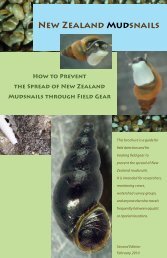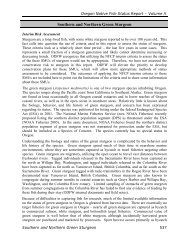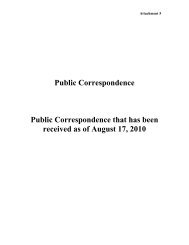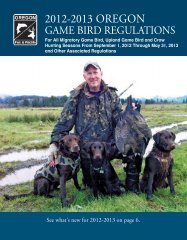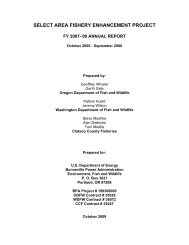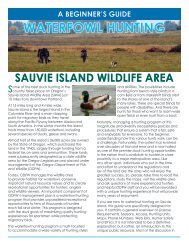Cascade Hatchery - Oregon Department of Fish and Wildlife
Cascade Hatchery - Oregon Department of Fish and Wildlife
Cascade Hatchery - Oregon Department of Fish and Wildlife
You also want an ePaper? Increase the reach of your titles
YUMPU automatically turns print PDFs into web optimized ePapers that Google loves.
CASCADE HATCHERY<br />
OPERATIONS PLAN<br />
2013
<strong>Cascade</strong> <strong>Hatchery</strong><br />
INTRODUCTION<br />
<strong>Cascade</strong> <strong>Hatchery</strong> is located along Eagle Creek, 2.5 miles west <strong>of</strong> <strong>Cascade</strong> Locks, <strong>Oregon</strong>, <strong>of</strong>f <strong>of</strong><br />
Interstate 84 (Exit 41). The site is located at an elevation <strong>of</strong> 100 feet above sea level, at latitude 45 o<br />
38’ 30” N (45.64167) <strong>and</strong> longitude 121 o 55’ 33” W (121.9258). The area <strong>of</strong> the site is 3.8 acres,<br />
owned by US Forest Service, Mt. Hood National Forest District.<br />
Water is supplied by gravity flow from Eagle Creek. The total water right is 20,205 gpm.<br />
The hatchery is staffed with 5.75 FTE’s.<br />
Rearing Facilities at <strong>Cascade</strong> <strong>Hatchery</strong><br />
Unit Unit Unit Unit Unit Number Total Construction<br />
Type Length Width Depth Volume Units Volume Material Age Condition Comment<br />
(ft) (ft) (ft) (ft 3 ) (ft 3 )<br />
Adult Holding Pond 210 35 4 22,050 1 22,050 concrete 1960 fair Very irregular shape<br />
Raceways 78 16 2.5 3,120 30 93,600 concrete 1960 fair<br />
Deep Troughs 16 1.42 1.25 28 5 140 Fiberglass 1985 good Not used for incubation<br />
Vertical Incubators 990 Various fair 66 stacks <strong>of</strong> 15 trays<br />
PURPOSE<br />
<strong>Cascade</strong> <strong>Hatchery</strong> was authorized under the Mitchell Act <strong>and</strong> began operating in 1959 as part <strong>of</strong> the<br />
Columbia River <strong>Fish</strong>eries Development Program – a program to enhance declining fish runs in the<br />
Columbia River Basin. The facility is used for egg incubation <strong>and</strong> rearing <strong>of</strong> coho.<br />
PROGRAM TYPE<br />
The ODFW <strong>Hatchery</strong> Management Policy defines hatchery programs as either harvest or<br />
conservation programs. Harvest programs operate to enhance or maintain fisheries without<br />
impairing naturally reproducing populations. Conservation programs operate to maintain or<br />
increase the number <strong>of</strong> naturally produced fish without reducing the productivity <strong>of</strong> naturally<br />
reproducing populations.<br />
<strong>Cascade</strong> <strong>Hatchery</strong> participates in both harvest <strong>and</strong> conservation programs. The Tanner Creek (014)<br />
Coho program is a harvest program used to mitigate for the loss <strong>of</strong> fishing <strong>and</strong> harvest<br />
opportunities due to habitat loss <strong>and</strong> migration blockage resulting from the Columbia Basin<br />
hydropower system. The Mid-Columbia/Leavenworth (508) Coho program <strong>and</strong> the Umatilla River<br />
(091) Coho Program are conservation programs for the restoration <strong>of</strong> extirpated populations.<br />
<strong>Cascade</strong> <strong>Hatchery</strong> Plan Page 1
GOALS<br />
Tanner Creek (014) Coho: Produce fish to help meet the goals <strong>of</strong> the Columbia River <strong>Fish</strong><br />
Management Plan (U.S. v. <strong>Oregon</strong> Agreement).<br />
Umatilla River (091) Coho: Produce fish from a locally-adapted broodstock for a restoration<br />
program to reintroduce coho into the Umatilla River Basin <strong>and</strong> establish ocean <strong>and</strong> in-river harvest<br />
opportunities.<br />
Mid-Columbia/Leavenworth (508) Coho: Produce fish for a restoration program to reintroduce<br />
coho into the Wenatchee River Basin.<br />
Clackamas River (019) Spring Chinook: Produce fish to mitigate for loss <strong>of</strong> spring Chinook catch in<br />
sport <strong>and</strong> commercial fisheries due to loss <strong>of</strong> habitat quantity <strong>and</strong> quality due to construction <strong>and</strong><br />
operation <strong>of</strong> PGE on the Clackamas River <strong>and</strong> USACE hydropower dams on the Columbia River.<br />
OBJECTIVES<br />
Objective 1:<br />
Foster <strong>and</strong> sustain opportunities for sport, commercial, <strong>and</strong> tribal fishers consistent<br />
with the conservation <strong>of</strong> naturally produced native fish.<br />
Coho:<br />
Tanner Creek (014) Stock:<br />
Produce 1,592,000 coho fingerlings (12,061 pounds) for transfer to Upper Herman Creek<br />
Ponds (Oxbow <strong>Hatchery</strong>).<br />
Produce 540,000 fingerlings (3,600 pounds) for transfer to Clackamas <strong>Hatchery</strong>.<br />
Umatilla River (091) Stock:<br />
Produce 1,000,000 smolts (66,667 pounds) for release into the Umatilla River System.<br />
Mid-Columbia/Leavenworth (508) Stock:<br />
Produce 196,500 smolts (9,825 pounds) for release into the Wenatchee River System.<br />
Produce 437,500 fish (16,767 pounds) for transfer to Leavenworth National <strong>Fish</strong> <strong>Hatchery</strong>.<br />
Spring Chinook:<br />
Produce 250,000 fingerlings (1,667 pounds) for transfer to Clackamas <strong>Hatchery</strong>.<br />
Objective 2: Contribute toward the sustainability <strong>of</strong> naturally produced native fish populations<br />
through the responsible use <strong>of</strong> hatcheries <strong>and</strong> hatchery-produced fish.<br />
Objective 3:<br />
Maintain genetic resources <strong>of</strong> native fish populations spawned or reared in captivity.<br />
<strong>Cascade</strong> <strong>Hatchery</strong> Plan Page 2
Objective 4: Restrict the introduction, amplification, or dissemination <strong>of</strong> disease agents in<br />
hatchery produced fish <strong>and</strong> in natural environments by controlling egg <strong>and</strong> fish<br />
movements <strong>and</strong> by prescribing a variety <strong>of</strong> preventative, therapeutic <strong>and</strong> disinfecting<br />
strategies to control the spread <strong>of</strong> disease agents in fish populations in the state.<br />
Objective 5:<br />
Objective 6:<br />
Minimize adverse ecological impacts to watersheds caused by hatchery facilities <strong>and</strong><br />
operations.<br />
Communicate effectively with other fish producers, managers <strong>and</strong> the public.<br />
CURRENT PRACTICES TO ACHIEVE OBJECTIVES<br />
The sections that follow describe the current hatchery practices used at this facility. Because<br />
ODFW hatcheries are managed to maximize use <strong>of</strong> the hatchery rearing space, hatchery operations<br />
are dynamic <strong>and</strong> subject to annual change depending upon statewide program needs.<br />
The Native <strong>Fish</strong> Conservation Policy, the <strong>Fish</strong> <strong>Hatchery</strong> Management Policy, the <strong>Fish</strong> Health<br />
Management Policy <strong>and</strong> <strong>Hatchery</strong> Genetic Management Plans provide guidelines for the<br />
management <strong>of</strong> wild <strong>and</strong> hatchery fish in <strong>Oregon</strong>. These policies describe the brood collection,<br />
rearing, release, <strong>and</strong> health management strategies currently used at this facility.<br />
Objective 1: Foster <strong>and</strong> sustain opportunities for sport, commercial, <strong>and</strong> tribal<br />
fishers consistent with the conservation <strong>of</strong> naturally produced native<br />
fish.<br />
Adult Collection<br />
Coho:<br />
Tanner Creek (014) Stock: Adult coho (Eagle Creek/Tanner Creek stock) return to Eagle<br />
Creek from late September to mid-November. Spawning occurs in October <strong>and</strong> November<br />
with a peak in November. No adult fish are collected at the hatchery. All adult fish are<br />
collected <strong>and</strong> spawned at Bonneville <strong>Hatchery</strong>. There is some adult salmon escapement<br />
above the hatchery.<br />
Umatilla River (091) Stock: Adults are collected <strong>and</strong> held at Three Mile Falls Dam; see the<br />
Umatilla <strong>Hatchery</strong> plan for details.<br />
Mid-Columbia/Leavenworth (508) Stock: No adults are collected at the hatchery; eggs are<br />
received from Methow <strong>Hatchery</strong> in December.<br />
Spring Chinook:<br />
Clackamas River (019) Stock: No adult fish are collected at <strong>Cascade</strong> <strong>Hatchery</strong>; see the<br />
Clackamas <strong>Hatchery</strong> Plan for details. Fingerlings are received from Oxbow <strong>Hatchery</strong> in<br />
early June.<br />
<strong>Cascade</strong> <strong>Hatchery</strong> Plan Page 3
Objective 2: Contribute toward the sustainability <strong>of</strong> naturally produced native fish<br />
populations through the responsible use <strong>of</strong> hatcheries <strong>and</strong> hatcheryproduced<br />
fish.<br />
Rearing <strong>and</strong> Release Strategies<br />
Rearing <strong>and</strong> release strategies are designed to limit the amount <strong>of</strong> ecological interactions occurring<br />
between hatchery <strong>and</strong> naturally produced fish. <strong>Fish</strong> are reared to sufficient size that smoltification<br />
occurs within nearly the entire population, which will reduce the retention time in downstream<br />
migration. Rearing on parent river water, or acclimation to parent river water for several weeks, is<br />
used to ensure strong homing to the hatchery, thus reducing the stray rate to natural populations.<br />
Various release strategies are used to ensure that fish migrate from the hatchery with least amount<br />
<strong>of</strong> interaction with native populations. The specific rearing <strong>and</strong> release strategies used at this<br />
hatchery are outlined below.<br />
Coho:<br />
Tanner Creek (014) Stock:<br />
Rear 1,592,000 fingerlings to a size <strong>of</strong> 132 fish/pound for transfer to Upper Herman Creek<br />
in late June. All fish are fin-clipped prior to transfer.<br />
Rear 540,000 fingerlings to a size <strong>of</strong> 150 fish/pound for transfer to Clackamas <strong>Hatchery</strong> in<br />
June. All fish are fin-clipped <strong>and</strong> 25,000 are coded-wire tagged prior to transfer.<br />
Umatilla River (091) Stock:<br />
Rear 1,000,000 smolts to a size <strong>of</strong> 15 fish/pound for transfer to Umatilla Acclimation site in<br />
mid-March for acclimation <strong>and</strong> release into the Umatilla River. 900,000 fish are fin-clipped<br />
<strong>and</strong> 100,000 are coded-wire tagged prior to transfer.<br />
Mid-Columbia/Leavenworth (508) Stock:<br />
These programs change each year as the needs are reassessed.<br />
Rear 110,000 fingerlings to a size <strong>of</strong> 30 fish/pound for transfer to Leavenworth National<br />
<strong>Fish</strong> <strong>Hatchery</strong> in Washington in late October. All fish are coded-wire tagged prior to<br />
transfer.<br />
Rear 327,500 fingerlings to a size <strong>of</strong> 25 fish/pound for transfer to Leavenworth National<br />
<strong>Fish</strong> <strong>Hatchery</strong> in Washington in February <strong>and</strong> March. All fish are coded-wire tagged prior<br />
to transfer.<br />
Rear 196,500 fingerlings to a size <strong>of</strong> 20 fish/pound for release into three tributaries <strong>of</strong> the<br />
Wenatchee River in Washington in late March. All fish are coded-wire tagged prior to<br />
transfer.<br />
<strong>Cascade</strong> <strong>Hatchery</strong> Plan Page 4
Spring Chinook:<br />
Clackamas River (019) Stock:<br />
Receive 250,000 fingerlings from Oxbow <strong>Hatchery</strong> at a size <strong>of</strong> 150 fish/pound in early June<br />
<strong>and</strong> rear to a size <strong>of</strong> 18 fish/pound for transfer to Clackamas <strong>Hatchery</strong> in October. All fish<br />
are fin-clipped at Oxbow <strong>Hatchery</strong> prior to transfer <strong>and</strong> 30,000 <strong>of</strong> those fish will be codedwire<br />
tagged at <strong>Cascade</strong> <strong>Hatchery</strong>.<br />
Objective 3: Maintain genetic resources <strong>of</strong> native fish populations spawned or<br />
reared in captivity.<br />
<strong>Oregon</strong>'s Native <strong>Fish</strong> Conservation Policy <strong>and</strong> <strong>Hatchery</strong> Genetic Management Plans outline<br />
broodstock selection <strong>and</strong> spawning protocols for some fish stocks. The following practices are<br />
currently being used at <strong>Cascade</strong> <strong>Hatchery</strong>:<br />
Broodstock Selection <strong>and</strong> Spawning<br />
Coho:<br />
Tanner Creek (014) Stock: Adult collection <strong>and</strong> spawning take place at Bonneville<br />
<strong>Hatchery</strong>; see the Bonneville <strong>Hatchery</strong> Plan for details.<br />
Umatilla River (091) Stock: Adult collection <strong>and</strong> spawning take place at Three Mile Falls<br />
Dam; see the Umatilla <strong>Hatchery</strong> plan for details. Tanner Creek (014) stock will be used as<br />
a backup source <strong>of</strong> eggs for this program.<br />
Mid-Columbia/Leavenworth (508) Stock:<br />
Leavenworth National <strong>Fish</strong> <strong>Hatchery</strong>.<br />
Eggs are received from Peshastin <strong>and</strong><br />
Spring Chinook:<br />
Clackamas River (019) Stock: Adult collection <strong>and</strong> spawning take place a Clackamas<br />
<strong>Hatchery</strong>; see the Clackamas <strong>Hatchery</strong> Plan for details.<br />
Objective 4: Restrict the introduction, amplification, or dissemination <strong>of</strong> disease<br />
agents in hatchery produced fish <strong>and</strong> in natural environments by<br />
controlling egg <strong>and</strong> fish movements <strong>and</strong> by prescribing a variety <strong>of</strong><br />
preventative, therapeutic <strong>and</strong> disinfecting strategies to control the<br />
spread <strong>of</strong> disease agents in fish populations in the state.<br />
<strong>Fish</strong> Health Management Programs—All Stocks<br />
ODFW has adopted a <strong>Fish</strong> Health Management Policy that describes measures that minimize the<br />
impact <strong>of</strong> fish diseases on the state’s fish resources. The primary objective <strong>of</strong> fish health<br />
management programs at ODFW hatcheries is to produce healthy smolts that will contribute to the<br />
fishery <strong>and</strong> return sufficient numbers <strong>of</strong> adults to continue propagation <strong>of</strong> the stocks <strong>and</strong> provide<br />
supplementation if desired. Equally important is to prevent the introduction, amplification or spread<br />
<strong>Cascade</strong> <strong>Hatchery</strong> Plan Page 5
<strong>of</strong> fish pathogens that might negatively affect the health <strong>of</strong> both hatchery <strong>and</strong> naturally reproducing<br />
stocks.<br />
ODFW has implemented both disease control <strong>and</strong> disease prevention programs at all <strong>of</strong> its facilities<br />
to achieve these objectives. These programs include the following st<strong>and</strong>ard elements:<br />
Disease Control (Reactive)<br />
• Perform necropsies <strong>of</strong> diseased <strong>and</strong> dead fish to diagnose the cause <strong>of</strong> loss.<br />
• Prescribe appropriate treatments <strong>and</strong> remedies to disease. This includes recommending<br />
modifications in fish culture practices, when appropriate, to alleviate disease-contributing<br />
factors.<br />
• Apply a disease control policy as stated in the <strong>Oregon</strong> Administrative Rules which dictates<br />
how specific disease problems will be addressed <strong>and</strong> what restrictions may be placed on<br />
movements <strong>of</strong> diseased stocks.<br />
• Conduct applied research on new <strong>and</strong> existing techniques to control disease epizootics.<br />
Disease Prevention (Proactive)<br />
• Routinely remove dead fish from each rearing container <strong>and</strong> notify ODFW <strong>Fish</strong> Pathology<br />
if losses are increasing. Monthly mortality records are submitted to <strong>Fish</strong> Pathology from<br />
each hatchery.<br />
• Routinely perform examinations <strong>of</strong> live fish to assess health status <strong>and</strong> detect problems<br />
before they progress to clinical disease or mortality.<br />
• Implement disease preventative strategies in all aspects <strong>of</strong> fish culture to produce a quality<br />
fish. This includes prescribing the optimal nutritional needs <strong>and</strong> environmental conditions<br />
in the hatchery rearing container based on historical disease events. It also involves the use<br />
<strong>of</strong> vaccines or antibiotics in order to avoid a disease problem.<br />
• Use a disease prevention policy that restricts the introduction <strong>of</strong> stocks into a facility. This<br />
will help avoid new disease problems <strong>and</strong> fish pathogens not previously found at the site.<br />
• Use sanitation procedures that prevent introduction <strong>of</strong> pathogens into <strong>and</strong>/or within a<br />
facility.<br />
• Conduct applied research on new <strong>and</strong> existing disease prevention techniques.<br />
• Utilize pond management strategies (e.g., Density Index <strong>and</strong> Flow Index guidelines) to help<br />
optimize the quality <strong>of</strong> the aquatic environment <strong>and</strong> minimize fish stress that can be<br />
conducive to infectious <strong>and</strong> noninfectious diseases. For example, a Density Index is used to<br />
estimate the maximum number <strong>of</strong> fish that can occupy a rearing unit based on the rearing<br />
<strong>Cascade</strong> <strong>Hatchery</strong> Plan Page 6
unit’s size. A Flow Index is used to estimate the rearing unit’s carrying capacity based on<br />
water flows.<br />
<strong>Fish</strong> Health Activities at <strong>Cascade</strong> <strong>Hatchery</strong><br />
Health Monitoring<br />
• Monthly health monitoring examinations <strong>of</strong> healthy <strong>and</strong> clinically diseased fish are<br />
conducted on each fish lot at the hatchery. The sample includes a minimum <strong>of</strong> 10<br />
moribund/dead fish (if available) <strong>and</strong> 4-6 live fish per lot.<br />
• All fish are given a health inspection no longer than 6 weeks before fish are released or<br />
transferred. This exam may be in conjunction with the routine monthly visit.<br />
• Examinations for Myxobolus cerebralis, agent <strong>of</strong> whirling disease, are conducted annually<br />
on 60 fish held for a minimum <strong>of</strong> 180 days at the facility.<br />
• At spawning, a minimum <strong>of</strong> 60 ovarian fluids <strong>and</strong> 60 kidney/spleen/pyloric caeca (based on<br />
a minimum sampling at the 5% incidence level) are examined for viral pathogens from each<br />
salmon lot. If pre-spawning mortality is above normal, necropsies are conducted on dead<br />
adult fish for bacteria, parasites <strong>and</strong> other causes <strong>of</strong> death.<br />
• At spawning, all females are tested for the presence <strong>of</strong> bacterial kidney disease (BKD).<br />
Eggs from positive females may be culled <strong>and</strong> destroyed, depending on the levels <strong>of</strong> BKD<br />
present <strong>and</strong> the availability <strong>of</strong> eggs to meet production needs.<br />
• Whenever abnormal behavior is reported or observed, or mortality exceeds 0.1% per day<br />
over five consecutive days in any rearing container, the fish pathologist will examine the<br />
affected fish, make a diagnosis <strong>and</strong> recommend the appropriate remedial or preventative<br />
measures.<br />
• Reporting <strong>and</strong> control <strong>of</strong> specific fish pathogens are conducted in accordance with the <strong>Fish</strong><br />
Health Management Policy. Results from each examination mentioned above are reported<br />
on the ODFW <strong>Fish</strong> Health or Virus Examination forms.<br />
<strong>Fish</strong> <strong>and</strong> Egg Movements<br />
• Movements <strong>of</strong> fish <strong>and</strong> eggs are conducted in accordance with the <strong>Fish</strong> Health Management<br />
Policy.<br />
Therapeutic <strong>and</strong> Prophylactic Treatments<br />
• At spawning, eggs are water-hardened in iodophor for disinfection.<br />
• Eggs from BKD-positive females are culled <strong>and</strong> destroyed.<br />
<strong>Cascade</strong> <strong>Hatchery</strong> Plan Page 7
• Juvenile fish are administered antibiotics orally as needed for the control <strong>of</strong> bacterial<br />
infections <strong>and</strong> for prevention <strong>of</strong> diseases.<br />
• Formalin <strong>and</strong>/or Hydrogen Peroxide are dispensed into water for control <strong>of</strong> parasites <strong>and</strong><br />
fungus on eggs <strong>and</strong> juveniles. Treatment dosage <strong>and</strong> exposure time varies with species, life<br />
stage <strong>and</strong> condition being treated.<br />
• Only approved or permitted therapeutic agents are used for treatments:<br />
Sanitation<br />
FDA labeled <strong>and</strong> approved for use on food fish<br />
Allowed by the FDA as an Investigational New Animal Drug<br />
Obtained by extra-label prescription from a veterinarian<br />
Allowed by the FDA as low regulatory priority or deferred regulatory status<br />
Approved by the FDA through USFWS for fish listed under the federal Endangered<br />
Species Act.<br />
• All eggs brought to the facility are surface-disinfected or water-hardened in buffered<br />
iodophor.<br />
• Disinfection footbaths (or other means <strong>of</strong> disinfection) are provided at the incubation<br />
facility’s entrance <strong>and</strong> exit areas while embryos are incubating in the facility.<br />
• All equipment (e.g., nets, tanks, rain gear, boots) is disinfected between uses with different<br />
fish/egg lots or different rearing containers.<br />
• Dead fish are disposed <strong>of</strong> promptly <strong>and</strong> in a manner that prevents introduction <strong>of</strong> disease<br />
agents to the waters <strong>of</strong> the state.<br />
• Rearing units are cleaned on a regular basis.<br />
• <strong>Fish</strong> transport trucks are disinfected between the hauling <strong>of</strong> different fish lots.<br />
• Rearing units are sanitized after removing fish <strong>and</strong> before introducing a new fish stock<br />
either by thorough cleaning <strong>and</strong> use <strong>of</strong> a disinfectant or by cleaning <strong>and</strong> leaving dry for an<br />
extended time.<br />
• Different lots <strong>of</strong> fish/eggs are physically segregated from each other by using separate<br />
ponds <strong>and</strong> incubator units.<br />
<strong>Cascade</strong> <strong>Hatchery</strong> Plan Page 8
Objective 5: Minimize adverse ecological impacts to watersheds caused by<br />
hatchery facilities <strong>and</strong> operations.<br />
Environmental Monitoring<br />
Primarily, environmental monitoring is conducted at ODFW facilities to ensure these facilities<br />
meet the requirements <strong>of</strong> the National Pollution Discharge Elimination Permit administered by the<br />
<strong>Oregon</strong> <strong>Department</strong> <strong>of</strong> Environmental Quality. It is also used in managing fish health. On a shortterm<br />
basis, monitoring helps identify when changes to hatchery practices are required. Long-term<br />
monitoring provides the ability to quantify water quality impacts resulting from changes in the<br />
watershed (e.g., logging, road building <strong>and</strong> urbanization). The following environmental parameters<br />
are currently monitored at all ODFW hatcheries:<br />
• Total Suspended Solids (TSS) – measured quarterly. Two composite samples are collected,<br />
one during normal operations <strong>and</strong> one during cleaning. Some facilities may take more<br />
samples because <strong>of</strong> multiple outfalls.<br />
• Settleable Solids (SS) – measured quarterly. Two grab samples are collected, one during<br />
normal operations <strong>and</strong> one during cleaning. Some facilities may take more samples because<br />
<strong>of</strong> multiple outfalls.<br />
• pH – measured quarterly when settleable solids are measured.<br />
• Water Temperatures – daily maximum <strong>and</strong> minimum water temperatures are measured<br />
within the hatchery. Temperature units are recorded for egg development in some<br />
hatcheries.<br />
• Dissolved Oxygen (DO) – measured only when conditions warrant (e.g., periods <strong>of</strong> low<br />
flows <strong>and</strong> high temperatures).<br />
• Air Temperatures – maximum <strong>and</strong> minimum temperatures are recorded daily at some<br />
stations, but there are no special monitoring requirements.<br />
• Flow Logs – changes in water flows through the hatchery ponds are recorded weekly.<br />
Objective 6: Communicate effectively with other fish producers, managers <strong>and</strong> the<br />
public.<br />
Coordination/Communication within ODFW<br />
Annual <strong>Fish</strong> Production Meetings: ODFW conducts meetings throughout the state to set annual<br />
fish production goals for all public hatcheries in <strong>Oregon</strong>. These meetings involve the participation<br />
<strong>Cascade</strong> <strong>Hatchery</strong> Plan Page 9
<strong>of</strong> ODFW research, management <strong>and</strong> fish culture staff as well as representatives from applicable<br />
federal agencies <strong>and</strong> tribes.<br />
Record Keeping: The following records are kept at all ODFW hatcheries:<br />
• Anadromous Adult Transaction Report – details the collection <strong>and</strong> disposition <strong>of</strong> all adult<br />
fish h<strong>and</strong>led at the facility.<br />
• Mark Recovery Report – details sex, fish length <strong>and</strong> tag information from all marked adult<br />
fish that are captured.<br />
• Egg <strong>and</strong> Fry Report – records all egg <strong>and</strong> fry movements, treatments, etc.<br />
• Monthly Ponded Report – updates hatchery operations from the previous month (i.e.,<br />
current number <strong>of</strong> fish, size, transfers or releases, feed conversion, mortality, medication,<br />
etc.).<br />
• Monthly Progress Report – document summarizing operational activities for the hatchery<br />
<strong>and</strong> all satellite facilities (e.g., fish culture, fish health, fish distribution, maintenance <strong>and</strong><br />
safety).<br />
• <strong>Fish</strong> Loss <strong>and</strong> Treatment Report – records disease problems <strong>and</strong> daily mortality.<br />
• <strong>Fish</strong> Loss Report/Investigation – when 1,000 or more juveniles or 10 or more adult fish are<br />
accidentally lost in a single accident.<br />
• Predator Mortality Report – documents any fish predators that may die at the hatchery<br />
facility.<br />
• <strong>Fish</strong> Liberation Reports – details information regarding all fish releases (e.g., fish numbers,<br />
size, location, method <strong>of</strong> release, marks, etc.).<br />
• Coded–Wire Tag Release Reports – record <strong>of</strong> all juvenile fish released with coded-wire<br />
tags.<br />
• Length Frequency Record – details fish lengths <strong>of</strong> all anadromous fish released (based on a<br />
sample <strong>of</strong> the releases).<br />
• Chemical use, waste discharge monitoring, purchasing, budget, hazardous materials, safety,<br />
vehicles, equipment, maintenance <strong>and</strong> alarm logs.<br />
• Visitor Log – some facilities record the daily visitor use <strong>of</strong> the facility; however, this is not<br />
a requirement.<br />
<strong>Cascade</strong> <strong>Hatchery</strong> Plan Page 10
<strong>Hatchery</strong> Management Information System (HMIS): Computerized system to collect, report,<br />
summarize <strong>and</strong> analyze hatchery production data. This system is a tool to be used in production<br />
control at all hatchery management levels.<br />
Interagency Coordination/Communication<br />
Production Advisory Committee (PAC): The Columbia River PAC is comprised <strong>of</strong> representatives<br />
from the regulatory management agencies <strong>and</strong> tribes. This group meets monthly to discuss<br />
anadromous fish production issues <strong>and</strong> to provide an opportunity for communication among the<br />
anadromous fish hatchery managers.<br />
Technical Advisory Committee (TAC): The Columbia River TAC is comprised <strong>of</strong> regulatory fish<br />
harvest technicians. This group provides management direction used in establishing hatchery fish<br />
production goals. TAC meets monthly.<br />
Pacific Northwest <strong>Fish</strong> Health Protection Committee (PNFHPC): This group is comprised <strong>of</strong><br />
representatives from U.S. <strong>and</strong> Canadian fish management agencies, tribes, universities, <strong>and</strong> private<br />
fish operations. The groups meets twice a year to monitor regional fish health policies <strong>and</strong> to<br />
discuss current fish health issues in the Pacific Northwest.<br />
In-River Agreements: State <strong>and</strong> tribal representatives meet annually to set Columbia River<br />
harvests as part <strong>of</strong> the U.S. v. <strong>Oregon</strong> Agreement. Periodic meetings are also held throughout the<br />
year to assess if targets are being met.<br />
In-Season Communications: Communication with PAC, the Columbia River Inter-Tribal <strong>Fish</strong><br />
Commission, Washington <strong>Department</strong> <strong>of</strong> <strong>Wildlife</strong>, Washington <strong>Department</strong> <strong>of</strong> <strong>Fish</strong>eries, U.S. <strong>Fish</strong><br />
<strong>and</strong> <strong>Wildlife</strong> Service <strong>and</strong> Idaho <strong>Department</strong> <strong>of</strong> <strong>Fish</strong> <strong>and</strong> Game takes place each year to coordinate<br />
proper fish <strong>and</strong> egg transfers in an effort to meet basin-wide goals at all facilities, where applicable.<br />
Streamnet (www/streamnet.org)): <strong>Hatchery</strong> return data are input into StreamNet, a cooperative<br />
information management <strong>and</strong> data dissemination project focused on fisheries <strong>and</strong> aquatic related<br />
data <strong>and</strong> data related services in the Columbia River basin <strong>and</strong> the Pacific Northwest. StreamNet is<br />
funded through the Northwest Power <strong>and</strong> Conservation Council's <strong>Fish</strong> <strong>and</strong> <strong>Wildlife</strong> Program by the<br />
Bonneville Power Administration <strong>and</strong> are administered by the Pacific States Marine <strong>Fish</strong>eries<br />
Commission. The data are maintained <strong>and</strong> disseminated through the Pacific States Marine<br />
<strong>Fish</strong>eries Commission (PSMFC).<br />
Communication with the General Public<br />
<strong>Cascade</strong> <strong>Hatchery</strong> receives approximately 5,000 visitors per year.<br />
<strong>Cascade</strong> <strong>Hatchery</strong> Plan Page 11
<strong>Cascade</strong> <strong>Hatchery</strong> Plan Page 12
<strong>Cascade</strong> <strong>Hatchery</strong><br />
Coho Salmon – Stock 14 (Tanner Creek)<br />
<strong>Cascade</strong> <strong>Hatchery</strong><br />
2,442,445 Green Eggs<br />
from Bonneville <strong>Hatchery</strong><br />
October/November<br />
Upper Herman Cr. Ponds<br />
1,592,000 @ 132 fish/lb<br />
June<br />
Clackamas <strong>Hatchery</strong><br />
540,000 @ 150 fish/lb<br />
June<br />
CCF Tongue Point<br />
Net Pens<br />
540,000 @ 28 fish/lb<br />
October<br />
Bonneville <strong>Hatchery</strong><br />
725,000 @ 17 fish/lb<br />
March<br />
Tanner Creek<br />
725,000 @ 13 fish/lb<br />
May<br />
CCF Youngs Bay<br />
Net Pens<br />
825,000 @ 25 fish/lb<br />
October<br />
Youngs Bay<br />
825,000 @ 13 fish/lb<br />
April<br />
Columbia River<br />
540,000 @14 fish/lb<br />
May<br />
<strong>Cascade</strong> <strong>Hatchery</strong> Plan Page 13
<strong>Cascade</strong> <strong>Hatchery</strong><br />
Coho Salmon – Stock 91 (Umatilla River)<br />
<strong>Cascade</strong> <strong>Hatchery</strong><br />
1,050,000 Green Eggs<br />
From Three Mile Falls Dam<br />
October<br />
Umatilla R. Acclimation<br />
1,000,000 @ 15 fish/lb<br />
March<br />
Umatilla River<br />
1,000,000 @ 15 fish/lb<br />
March<br />
<strong>Cascade</strong> <strong>Hatchery</strong> Plan Page 14
<strong>Cascade</strong> <strong>Hatchery</strong><br />
Coho Salmon – Stock 508 (Mid-Columbia)<br />
<strong>Cascade</strong> <strong>Hatchery</strong><br />
635,000 Eyed Eggs<br />
from Leavenworth & Methow<br />
hatcheries<br />
December<br />
Transfer<br />
Release<br />
Leavenworth NFH<br />
327,000 @ 25 fish/lb<br />
Feb-Mar<br />
Leavenworth NFH<br />
110,000 @ 30 fish/lb<br />
early December<br />
Wenatchee R. Tributaries<br />
196,000 @ 20 fish/lb<br />
March<br />
<strong>Cascade</strong> <strong>Hatchery</strong> Plan Page 15
<strong>Cascade</strong> <strong>Hatchery</strong><br />
Spring Chinook – Stock 19 (Clackamas River)<br />
<strong>Cascade</strong> <strong>Hatchery</strong><br />
250,000 fingerlings<br />
From Oxbow <strong>Hatchery</strong><br />
June<br />
Clackamas <strong>Hatchery</strong><br />
250,000 fish @ 10 fish/lb<br />
October<br />
Clackamas River<br />
250,000 fish @ 10 fish/lb<br />
October<br />
<strong>Cascade</strong> <strong>Hatchery</strong> Plan Page 16


